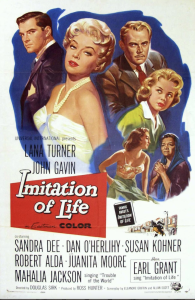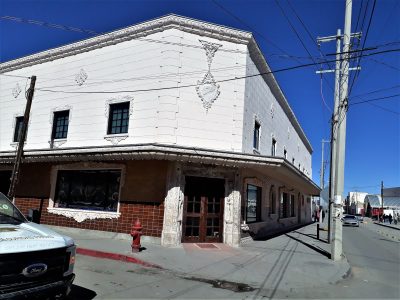#39: House Of Bamboo by Earl Grant
City: Hull, QC
Radio Station: CKCH
Peak Month: May 1960
Peak Position in Hull ~ #4
Peak position in Vancouver ~ did not chart
Peak Position on Billboard Hot 100 ~ #88
YouTube: “House Of Bamboo”
Lyrics: “House Of Bamboo”
Earl Grant was born in a small town in southeastern Oklahoma in 1931. Grant attended four music schools, eventually becoming a music teacher. He augmented his income by performing in clubs during his U.S. Army service, throughout which he was stationed in Fort Bliss, Texas. Grant signed with Decca Records in 1957. His first album was released in 1958 titled The Versatile Earl Grant. His first single “The End” reached #7 on the Billboard Hot 100 on October 13, 1958. It would be his only Top 40 hit on the Billboard Hot 100. “The End” subsequently appeared in the motion pictures Iron Maze (1991), Days of Tomorrow (1993), and A Dirty Shame (2004), and the TV show Lovecraft Country (2019).
Subsequently, Earl Grant released his second album The End. His third album, Midnight Earl, was also released in 1958. A fourth album, Grant Takes Rhythm, was released in 1959. A second single, “Evening Rain”, was released in 1959. It stalled at #63 on the Billboard Hot 100.
In 1959, Earl Grant appeared in the film Imitation of Life, where he sang the theme song. The film starred Lana Turner, Sandra Dee and Mahalia Jackson.

Earl Grant also appeared in 1959 in the film Juke Box Rhythm starring Jack Jones, George Jessel, Johnny Otis and The Treniers.

On November 15, 1959, Earl Grant appeared on The Ed Sullivan Show to perform “Malagueña”. In 1960, Earl Grant released his third single, “House Of Bamboo” from the album Grant Takes Rhythm. Earl Grant performed “House Of Bamboo” on The Ed Sullivan Show on February 21, 1960.

“House Of Bamboo” was written by Bill Crompton and obscure songwriter Norman Murrells. Crompton was born in the UK and co-wrote songs recorded by The Shadows, Craig Douglas, Don Rondo, Johnny Kidd & The Pirates, Dickie Valentine, Winifred Atwell, and others. After emigrating to Canada in the 1970s, in the 1980s Crompton became the manager of the Canadian musician Richard Stepp. The song was first recorded by Andy Williams in November 1958 as the B-Side to “Hawaiian Wedding Song”.
In the song, “The House Of Bamboo” there is a club with an address: “number 54.” It has a bamboo roof, floor, and walls. It’s also referred to in the lyrics as a casino. It’s run by a guy named Soho Joe who has an espresso machine at the counter. People also drink a Chino. A Chino is an Italian soft drink invented in 1932. Chinotto is a sparkling Italian soft drink named after the small, bitter citrus fruit of the Myrtle-leaved orange tree. The tree is believed to have originated in China, hence the name, Chino. Today Chinotto fruit is mostly cultivated in Italy, where the peel extract is an essential ingredient in Italian Bitters (‘Amari’); alcoholic liqueurs drunk either as a digestif or an aperitif. San Pellegrino formulated the first Chinotto soft drink in 1932, marketed under the brand name of Chino.
At the club people dance the cha-cha and the bolero “in a sombrero.” The sombrero is a type of wide-brimmed Mexican men’s hat used to shield the face and eyes from the sun. It usually has a high, pointed crown, and an extra-wide brim (broad enough to cast a shadow over the head, neck, and shoulders of the wearer) that is slightly upturned at the edge. Typically, a sombrero has a chin strap to hold it in place.
The cha-cha is a dance that originated in the mid-50s in Cuba as a variation on the Mambo. The cha-cha has a syncopated three-step chasse, giving it a distinctive flair. The bolero is a Spanish dance that emerged after 1750 and was popular in Madrid, La Mancha, Andalusia and Murcia. Bolero was performed as a solo or partner dance with a moderately slow tempo, accompanied by guitar and castanets. The bolero inspired classical works by Chopin, Schumann, Verdi, Bériot, Saint-Saëns, Debussy, Ravel and others.
The House of Bamboo “rocks like a jukebox.” In 1889 the first coin-operated music machine was introduced in San Francisco at the Royale Palais Saloon. Since there was no amplifier, those paying to hear a song had to use a listening tube, placing it against their ear. In 1906 at the Pan-Pacific Exposition, there was an Automatic Entertainer featuring a forty inch horn on top of the cabinet. The only problem was the amplifier had little volume. This prevented patrons in saloons from being able to hear the records once there were many people in the room. In 1918, Hobart C. Niblack invented a mechanism that allowed records to be changed in a music box. In 1925, the 78 RPM was introduced into the market and jukeboxes emerged that could play 78 RPM discs. In 1927, this became marketed as a jukebox by the Automated Musical Instrument Company. In 1928, Justus P. Seeburg marketed a music system that featured an electrostatic loudspeaker with a record player that was coin- operated. Patrons could select from a choice of eight discs. Often radio recorded live performances from upscale lounges and hotel ballrooms. Listening to a record on a jukebox was the only other way to hear the song before deciding to purchase a copy. During the Great Depression, record companies depended on sales of records to play on jukeboxes to salvage a shrinking market when individual record buyers opted to not shell out for personal record collecting.
In addition to Seeburg, there were jukeboxes marketed by the Rock-Ola Manufacturing Company, Wurlitzer and Automatic Musical Instruments Co. The golden era of jukebox music was in the 1940s to 1960s. The 45 RPM was introduced in 1950 and helped increase the number of discs that could be played in a jukebox. However, the invention of the portable radio in the 1950’s, and the cassette player in the 1960’s, contributed to the decline of usage of jukeboxes in cafes, soda shops and other gathering places.
In essence, The House of Bamboo is a metaphor for a paradise or idyllic place. Bamboo is known for its resilience and flexibility, symbolizing durability and adaptability. The song combines this imagery with the longing for an idealized and romanticized place. It transports listeners to a serene and peaceful refuge, far away from the worries and stress of everyday life. The lyrics evoke a sense of escape and the desire for a simpler, more harmonious existence, where there is free time to relax, socialize and have fun.
“House Of Bamboo” peaked at #1 in Rochester (NY), #4 in Hull (PQ), #6 in Lafayette (LA), and #10 in Fort William (ON) and Albany (NY). On the Billboard Hot 100 the single stalled at #88.
On March 27, 1960, Earl Grant performed the Ray Charles R&B hit from 1956 titled “Hallelujah I Love Her So” on The Ed Sullivan Show. On October 2, 1960, Earl Grant returned again as a guest on The Ed Sullivan Show where he performed “Ol’ Man River”.
In 1961, the album Ebb Tide (And Other Instrumental Favorites) sold over one million copies, and earned a gold record from the music industry. In 1962, Earl Grant released a single titled “Swingin’ Gently” which climbed to #44 on the Billboard Hot 100. Later that year, Earl Grant performed “Sweet Sixteen Bars” on American Bandstand on October 27, 1962. The single charted to #9 on the Billboard R&B singles chart. As well, his album Beyond The Reef (And Other Instrumental Favorites) reached #17 on the Billboard pop album chart. On the screen, in 1962 Earl Grant appeared in the role of a piano player in the film Tender Is the Night, starring Jason Robards Jr. and Jennifer Jones. He had another appearance as a guest on The Ed Sullivan Show on March 25, 1962.
In 1965, Earl Grant released a cover of the Ben E. King hit from 1961 titled “Stand By Me”. It was his last charting single peaking at #75 on the Hot 100.
Earl Grant also recorded the Christmas holiday favorite “Silver Bells” which charted on six occasions on the Billboard Christmas Singles chart between 1966 and 1972. In 1969, Earl Grant appeared on February 25, 1969, in an episode of the TV show It Takes A Thief.
On June 9, 1970, Earl Grant left Los Angeles on route to perform a concert in Juarez, Mexico, on Friday June 12th at the La Fiesta dinner nightclub. However, on June 10th Grant was killed in a motor vehicle accident on a New Mexico highway I-10 near Lordsburg. His Silver Shadow Rolls Royce ran off the highway and overturned 166 miles northwest of his destination on the New Mexico-Mexico border. The La Fiesta dinner club in Juarez, Mexico, had many famous stars appear including Frank Sinatra, Bobby Rydell, The Kingston Trio, and Nat “King” Cole.

Entrance to La Fiesta Dinner Club, Juarez, Mexico

Interior to La Fiesta Dinner Club, Juarez, Mexico
In May of 1971 Mrs. Catherine Cooper, Grant’s mother, filed a lawsuit against two firms, Rolls Royce and Bristol-Myers Company in the wrongful death of her son. The suit was filed in the Los Angeles Superior Court. She claimed that the Rolls Royce that her son was driving had a defective steering mechanism and brakes. Mrs. Cooper also claimed that medication that Earl Grant had taken to keep him awake while driving did not work. The Bristol-Myers Company advertised that the tablets that Grant took were supposed to keep the driver awake “while driving under monotonous conditions.”
Posthumously, Earl Grant had numbers of his recordings featured in motion pictures and TV shows in successive decades. This includes his recording of “One Way Street” in the films Heavy (1995) and Mojave Moon (1996). As well, “Moonlight in Vermont” was featured in Heavy, and “Little Girl Lost” in Mojave Moon. In 2019, Grant’s recording of “Not One Minute More” appeared in the TV show Black Mirror.
Blogger, Chet Wallace writes “Even though he didn’t “come out” during his lifetime, it is believed that Earl Grant was a homosexual, which was “a career destroyer” due to its non-acceptance of the time. …there is no mention of Grant marrying or having children. Not that this was a stereotype of homosexual men during this time, but Earl Grant did like to dress stylishly and show off the clothing he wore. He was frequently photographed with a fedora during a time period when men were wearing hats of this sort less and less. Many of Earl Grant’s album covers featured him wearing a fedora.” (Not that being gay meant you were predisposed to wearing flashy clothes. But Chet Wallace is pointing out that wearing loud suits and fedora hats in the late 50s into the 60s made Earl Grant stand out from contemporary recording artists like Andy Williams, Ben E. King, Brook Benton, Jackie Wilson and Wilbert Harrison).
August 23, 2024
Ray McGinnis
References:
“Auto Accident Kills Earl Grant, Organist, Singer,” Meridian Journal, Meridan-Southington (CT), June 11, 1970.
“Earl Grant, a Popular Organist and Record Star, Dies in Crash,” New York Times, June 11, 1970.
Chet Wallace, “Earl Grant: The Life of an African American Musician Part III,” thechetwallace.com.
Earl Grant, “House Of Bamboo,” The Ed Sullivan Show, February 21, 1960.
“Earl Grant,” Imdb.com.
“Bill Crompton,” feenotes.com.
“Have You Taken a Chino in Italy?,” Dream of Italy.com, July 14, 2010.
“San Pellegrino Chino,” DrinkStation, January 29, 2010.
“The Wide World of Mexican Sombreros,” theculturetrip.com.
“Unveiling the Rhythm: The Captivating History of Cha-Cha-Cha and its American Dance Odyssey,” dance-flavor.com, December 1, 2023.
Cora Harris, “Bolero Dance: Origin, Types, Steps, Costume, Music & More,” City Dance, May 2, 2024.
Mary Bellis, History of the Jukebox, Thoughtco.com.
Gert J. Almind, History of the Jukebox, Radio Museum.org.

CKCH 970-AM Hull (QC) Top Ten | May 21, 1960

Leave a Reply